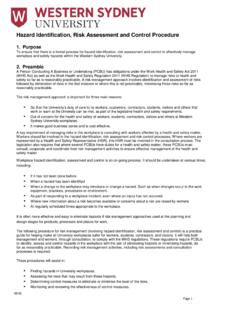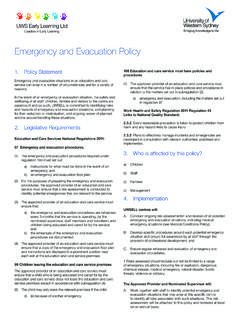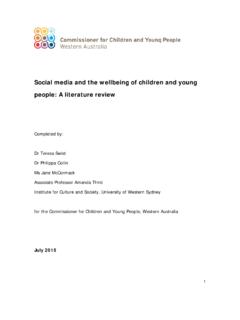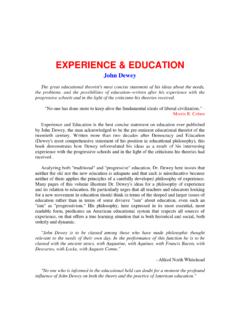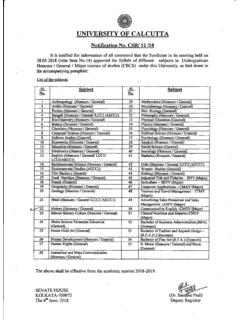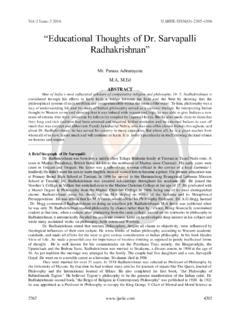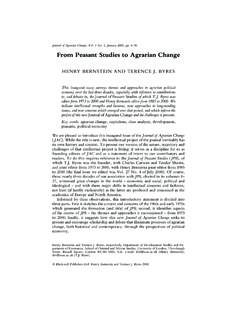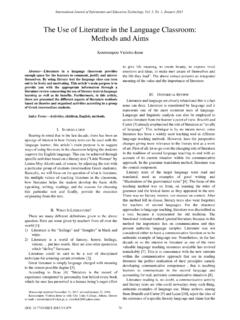Transcription of Together-in-Difference: Beyond Diaspora, Into Hybridity
1 Institute for Culture & Society Pre-Print Journal Articles Ang (2003): together -in-Difference: Beyond Diaspora, into Hybridity . 1 together -in-Difference: Beyond Diaspora, into Hybridity Ien Ang This is an electronic version of an article published as: Ang, I. 2003, together -in-difference: Beyond Diaspora, into Hybridity , Asian Studies Review, 27(2): 141-154. The definitive version of this article is available online at: ~content=a771577492~db=all~order=page (institutional or subscribed access may be required) The journal Asian Studies Review is available online: ~content=t713613499 (institutional or subscribed access may be required) doi: Copyright remains with the Asian Studies Association of Australia Disclaimer Please note that this is an electronic, pre-print version of this article produced by the Institute for Culture & Society, University of Western Sydney, in accordance with the requirements of the publisher.
2 Whilst this version of the article incorporates refereed changes and has been accepted for publication, differences may exist between this and the final, published version. Citations should only be made from the published version. User Agreement Copyright of these pre-print articles are retained by the author. Users may download and/or print one copy of any article to facilitate their own study or non-commercial research. Wider circulation and distribution of the material and/or use of it in profit-making activities is prohibited. URLs to access this post-print version can be freely distributed: Institute for Culture & Society Pre-Print Journal Articles Ang (2003): together -in-Difference: Beyond Diaspora, into Hybridity . 2 together -in-Difference: Beyond Diaspora, into Hybridity1 Ien Ang University of Western Sydney One of the most urgent predicaments of our time can be described in deceptively simple terms: how are we to live together in this new century this century that has begun so sadly, so violently?
3 We and together are the key sites of contestation here. In the last few decades of the twentieth century, the growing global prominence of what has come to be called identity politics has bred a profound suspicion of any universalising claims to a common humanity . In this climate, the very idea of living together becomes hugely daunting. What are the possibilities of a sense of togetherness that can transcend rampant division and fragmentation based on particularist identities, without returning to the old hegemony of an assimilationist, Eurocentric homegeneity? How, in short, can we live together -in-difference? In this paper, I will argue for the importance of Hybridity in a world in which we no longer have the secure capacity to draw the line between us and them, the different and the same, here and there, and indeed, between Asian and Western.
4 In Clifford Geertz s words, we now live in a globalised world in which there is a gradual spectrum of mixed-up differences (Geertz 1988,148). Hybridity is a necessary concept to hold onto in this condition, because unlike other key concepts in the contemporary politics of difference such as diaspora and multiculturalism it foregrounds complicated entanglement rather than identity, togetherness-in-difference rather than separateness and virtual apartheid. It is also, as I will argue, a concept that prevents the absorption of all difference into a hegemonic plane of sameness and homogeneity. Claiming one s difference and turning it into symbolic capital has become a powerful and attractive strategy among those who have been marginalised or excluded from the structures of white or Western hegemony. Diaspora has been an increasingly popular name for that symbolic capital in recent years.
5 In light of global power relations, the significance of diasporic identity lies in its force as a symbolic declaration of liberation from the abject position of ethnic minority in an oppressive national hegemony (Clifford 1997, 255). As James Clifford has remarked, diasporic identifications reach Beyond ethnic status within the composite, liberal state , imparting a sense of being a people with historical roots and destinies outside the time/space of the host nation (Clifford 1997, 255). It is undeniable that the idea of diaspora is an occasion for positive identification for many, providing a powerful sense of transnational belonging and connection with dispersed others of similar historical origins. The Chinese diaspora, for example, has by virtue of its sheer critical mass, global range and mythical might, evinced an enormous power to operate as a magnet for anyone who can somehow be identified as Chinese no matter how remote the ancestral links.
6 This reaching back to one s ancestral roots can be a powerful, almost Utopian, emotional pull. But notwithstanding the obvious benefits to some, what are the costs of this recent valorisation of diaspora? 1 Most of the material in this paper was published in a different form in my book On Not Speaking Chinese: Living Between Asia and the West. London: Routledge. Institute for Culture & Society Pre-Print Journal Articles Ang (2003): together -in-Difference: Beyond Diaspora, into Hybridity . 3 While the transnationalism of diasporas is often taken as an implicit point of critique of the territorial boundedness and internally homogenising perspective of the nation-state, the limits of diaspora lie precisely in its own assumed boundedness, its inevitable tendency to stress its internal coherence and unity, logically set apart from others.
7 Diasporic formations transgress the boundaries of the nation-state on behalf of a globally dispersed people for example, the Chinese but paradoxically this transgression can only be achieved by drawing a boundary around the diaspora, the Chinese people themselves. It is therefore important, in my view, to recognise the double-edgedness of diasporic identity: it can be the site of both support and oppression, emancipation and confinement, solidarity and division. Let me first pause at the increasing popularity of the term diaspora itself. While this term was once reserved as a descriptor for the historical dispersion of Jewish, Greek and Armenian peoples, today it tends to be used much more generically to refer to almost any group living outside its country of origin, be it Italians outside Italy, Africans in the Caribbean, North America or Western Europe, Cubans in Miami and Madrid, Koreans in Japan, or Chinese all over the world.
8 Indeed, as Kachig Tololyan remarks, the significant transformation of the last few decades is the move towards re-naming as diasporas .. communities of dispersion .. which were known by other names until the late 1960s: as exile groups, overseas communities, ethnic and racial minorities, and so forth (Tololyan 1996, 3). To put it differently, the burgeoning language and consciousness of diaspora is itself a manifestation and effect of intensifying cultural globalisation. While migrations of people have taken place for centuries and have been a major force in the creation of the modern world of nation-states since the nineteenth century, it is only in the past few decades with the increased possibilities of keeping in touch with the old homeland and with coethnics in other parts of the world through faster and cheaper jet transport, mass media and electronic telecommunications that migrant groups have become collectively more inclined to see themselves not as minorities within nation- states, but as members of global diasporas that span national boundaries.
9 For example, while overseas Chinese used to be the common English term to describe the dispersed migrant Chinese communities around the world that were usually referred to in local terms, in the past decade or so they have been increasingly frequently described collectively and unifyingly, in global terms, as Chinese diaspora . It is clear then that the discourse of diaspora owes much of its contemporary currency to the economic, political and cultural erosion of the modern nationstate as a result of postmodern capitalist globalisation what Tololyan calls the transnational moment . Tololyan even nominates diasporas as the paradigmatic Others of the nation-state: the increasing assertiveness of diasporic groups in representing and organising themselves as transnational communities forces nation-states to confront the extent to which their boundaries are porous and their ostensible homogeneity a multicultural heterogeneity (Tololyan 1991, 5).
10 Seen in this way, diasporas not only are placed in direct opposition to the nation-state, but are also implicitly designated as key socio- cultural formations capable of overcoming the constrictions of national boundaries the means through which people can imagine and align themselves Beyond the nation. Much contemporary work on diaspora, both scholarly and popular, represents this transnational diasporic imaginary as a liberating force. Simply put, the nation-state is cast as the limiting, homogenising, assimilating power structure, which is now, finally, being deconstructed from within by those groups who used to be marginalised within its borders but are now bursting out of them through their diasporic transnational connections. Institute for Culture & Society Pre-Print Journal Articles Ang (2003): together -in-Difference: Beyond Diaspora, into Hybridity .
